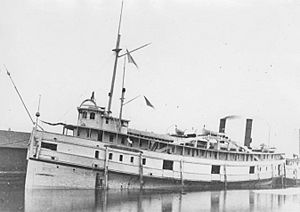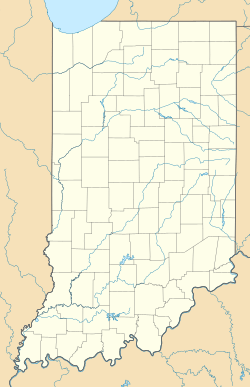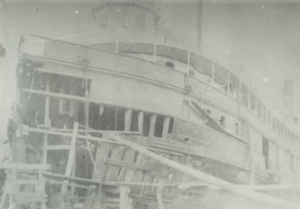SS Muskegon facts for kids
class="infobox " style="float: right; clear: right; width: 315px; border-spacing: 2px; text-align: left; font-size: 90%;"
| colspan="2" style="text-align: center; font-size: 90%; line-height: 1.5em;" | 
|}
The SS Muskegon was a large wooden ship from America. It was built to carry both passengers and goods. On October 6, 1910, the ship caught fire and sank near Michigan City, Indiana. At the time, it was unloading a cargo of sand. Today, the remains of the Muskegon are an important historical site. They were added to the National Register of Historic Places on April 26, 1989.
Contents
- Building a Steamship: Design and Construction
- Life at Sea: The Ship's Service History
- The Final Fire: Burning and Sinking
| History | |
|---|---|
| Name |
|
| Operator | Independent Sand Company |
| Port of registry | |
| Builder | Ira Lafrinnier, Cleveland, Ohio |
| In service | July 3, 1872 |
| Out of service | October 6, 1910 |
| Identification | U.S. Registry #20470 |
| Fate | Burned off Michigan City, Indiana |
| General characteristics | |
| Class and type | Bulk Freighter |
| Tonnage | 1275.57 Gross register tons |
| Length |
|
| Beam | 39.8 ft (12.1 m) |
| Height | 32 ft (9.8 m) |
| Draught | 23 ft (7.0 m) |
| Installed power | 2 x Scotch marine boilers |
| Propulsion | 700 horsepower High pressure condensing engine |
|
|
|
| Location | Off the coast of Michigan City, Indiana, LaPorte County, Indiana |
| Nearest city | Michigan City, Indiana |
| Built | 1872 |
| Architect | Ira Lafrinnier |
| Architectural style | Steamship |
| NRHP reference No. | 89000290 |
| Added to NRHP | April 26, 1989 |
History of the SS Muskegon
Building a Steamship: Design and Construction
The ship we know as the Muskegon was first built in 1872. It was named the Peerless back then. Ira Lafrinnier built her in Cleveland, Ohio. The Peerless was launched into the water on June 15, 1872.
This ship was quite large for its time. It measured 220 feet (67 m) long overall. Its widest part, called the beam, was 39.8 feet (12.1 m) across. The hull, or bottom part, was 23 feet (7.0 m) deep. The ship weighed 1275.57 gross tons. To move, it used a powerful 700 horsepower steam engine. This engine was powered by two coal-fired boilers. Both the engine and boilers were made by the Globe Iron Works in Cleveland, Ohio.
Life at Sea: The Ship's Service History
The Peerless began its work on July 3, 1872. It joined the Leopold & Austrian’s Lake Superior Line in Chicago, Illinois. Its official registration number was US20470. In September 1877, the ship had to throw some of its cargo overboard. This included flour, feed, and about 26 cattle and 70 sheep.
The Peerless often needed repairs. In August 1882, it went in for maintenance. On November 26, 1884, a fire broke out on the ship in Chicago. Luckily, it was repaired and updated the next year. The Chicago Dry Dock Company did this work.
In November 1894, the ship was held at Sault Ste. Marie, Michigan. This was due to a health concern on board. In 1896, the Peerless was sold to a new company. This was the Lake Michigan & Lake Superior Transportation Company. On October 27, 1895, a part of its engine broke near St. Joseph, Michigan. The tugboat Perfection came to its rescue. In October 1898, the ship's machinery stopped working again. It had to be towed to Marquette, Michigan.
On September 7, 1899, the Peerless crashed into another ship. It hit the schooner A. Stewart and sank. But it was raised from the water just four days later. Repairs were made in Howard's Bay, West Superior, Wisconsin.
In 1906, the ship was sold to the Chicago Transportation Company. Around this time, it was used for entertainment while docked in Chicago. In 1907, it was sold again. The Muskegon & Chicago Navigation Company bought it. They were based in Muskegon, Michigan. This is when the ship was renamed Muskegon.
In 1908, the Muskegon was changed into a bulk freighter. This means it was set up to carry large amounts of loose goods. The Ship Owners Dry Dock Company in Chicago did this work. In 1909, the Muskegon was sold to the Independent Sand Company. They were also from Chicago. The ship was then changed again in Muskegon. It became a sandsucker, designed to collect sand.
The Final Fire: Burning and Sinking
On October 6, 1910, the Muskegon was at a dock in Michigan City, Indiana. It was busy unloading a cargo of sand. Suddenly, a fire started inside its hull. People believed the fire might have started because some kerosene spilled near the ship's boilers.
The fire was very strong and burned the Muskegon down to the waterline. The ship then sank right at the dock. It stayed there for many months. Finally, on June 10, 1911, the remains of the ship were refloated. They were then towed out into the harbor and purposely sunk. After losing the Muskegon, the Independent Sand Company used their insurance money. They bought another sandsucker ship called the J.D. Marshall.
The Muskegon Today: A Shipwreck Site
Today, the remains of the Muskegon lie at the bottom of the water. They are in 32 feet (9.8 m) of water. Many parts of the ship's machinery can still be found at the site. This includes the large boilers that powered the ship. You can also see the propeller and the long shaft that connected it to the engine. There are also several gears that were once part of the ship's engine. This shipwreck is a fascinating place for divers and historians to explore.
Images for kids






